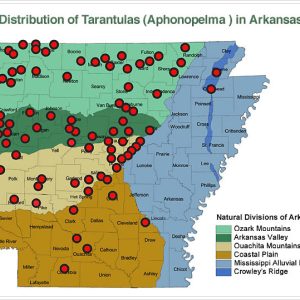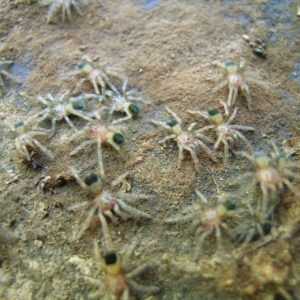calsfoundation@cals.org
Tarantulas
Tarantulas are the largest spiders in Arkansas and are among the most recognizable. Tarantulas are relative newcomers to Arkansas, having arrived in the state about 8,000 years ago. At that time, the climate of North America was much warmer and drier than it is today. Because of higher temperatures and lower amounts of rainfall, habitats more typical of the southwestern United States and the Great Plains expanded eastward into Arkansas and Missouri. Along with drier habitats came many of the animals associated with them, such as tarantulas and scorpions. As the climate became cooler and wetter about 4,000 years ago, these species did not retreat west. Instead, they became isolated within suitable patches of open, dry habitat surrounded by increasing amounts of forest.
In Arkansas, tarantulas are known to range from the Ozark Mountains southward across the Arkansas River Valley and Ouachita Mountains, into the West Gulf Coastal Plain. While a few records of tarantulas in Crowley’s Ridge exist, these spiders appear to be largely absent from most of the Mississippi Alluvial Plain.
The lifespan of a tarantula is uncommonly long by spider standards. Sexual maturity is reached at about ten years of age, and although males die shortly after mating, females can live for up to twenty years. The majority of these years are spent in underground burrows, which can be ten to twenty-four inches deep.
Tarantulas are not active, roaming hunters; they sit in or near the opening of their burrow and wait for potential prey to pass by. Once prey is detected, the tarantula rushes forward, seizing its prey, inserting its fangs, and injecting venom to immobilize its captive. Beetles, grasshoppers, crickets, and other spiders make up the typical diet of a tarantula.
Fall is tarantula mating season in Arkansas, and males search out females. Mature males generally leave their burrows sometime between August and October. These wandering males account for most sightings of tarantulas in Arkansas. Males may wander long distances, up to one and a half miles, in search of a mate. After mating, male tarantulas typically die from starvation with the coming of winter, while the females spend the winter in their burrows. The following year, sometime in early summer, fertilized females begin to create silken egg sacs, into which 200 to 800 eggs are deposited. Once finished, the egg sac is vigorously guarded and tended by the doting mother. Eggs typically hatch during July and August.
Tarantulas possess mild venom that is used to subdue prey. The bite of an Arkansas tarantula has been described as being about as painful as a bee sting.
Much of what we now know about tarantulas in Arkansas is due to the work of William J. Baerg, the father of North American tarantula research. In 2004, the Arkansas Natural Heritage Commission contributed to this knowledge base with the first ever statewide citizen-science effort to map tarantula distribution: the Arkansas Tarantula Survey.
For additional information:
Baerg, William J. The Tarantula. Lawrence: University Press of Kansas, 1958.
Warriner, Michael D. “Distribution and Taxonomic Status of Tarantulas in Arkansas (Theraphosidae: Aphonopelma).” Journal of the Arkansas Academy of Science 62 (2008): 107–114. Online at https://scholarworks.uark.edu/jaas/vol62/iss1/17/ (accessed July 30, 2023).
Michael D. Warriner
Arkansas Natural Heritage Commission
 Arachnids
Arachnids Science and Technology
Science and Technology Applied Entomology by William Baerg
Applied Entomology by William Baerg  Tarantula
Tarantula  Tarantula Distribution
Tarantula Distribution  Tarantula with Egg Sac
Tarantula with Egg Sac  Tarantulas
Tarantulas 




Saw my first ever tarantula, on the Vista Trail at Crystal Springs Campground on the hill side across the water from the campground. Seemed to be wandering. Time was 11:10 a.m., sunny, low 70s.
In October 2023, my wife and I saw a Tarantula on our drive that seemed to be wandering in several directions. It must have been looking for a mate. I have seen a couple crossing my rock road in the past. We live in the Hand Cove area of Baxter County.
Just now 10/10/23 at 10:15 a.m. in the Ozarks (Diamond City), my dog spotted a tarantula walking across the dirt road. I was shocked! Keeping her from getting any closer to it, we both quickly walked away and I immediately looked it up. Happy to know that they mostly stay near their holes. It must have been a male looking for its mate.
Texas brown tarantula, Berryville, Arkansas.
Early this morning, the 4th of July, 2023, I saw my first tarantula. When I tried to cover it with a dog dish, it escaped through our doggie door. I am in a wheelchair and was not quick enough to catch it.
Just saw my first tarantula of Arkansas on my new property in Batesville. It’s so cool.
Yesterday evening, 6/19/13, I found and captured a tarantula in Maumelle, AR. Not sure whether it is male or female. It was crossing the road at the time of capture.
Had just sat down on the ole sofa, when I saw something crawling toward me. What the hell, it was a tarantula. Just like in the movies, it looked horrible. Should I call the wife, or keep it to myself? I grabbed the dust pan, broom, and quickly escorted it to the deck. Then I called the wife. She didn’t seem perturbed at all, while my heart was pounding. The next thing was to check the Internet about these darn things. Anyone else ever find these creatures in Cherokee Village?